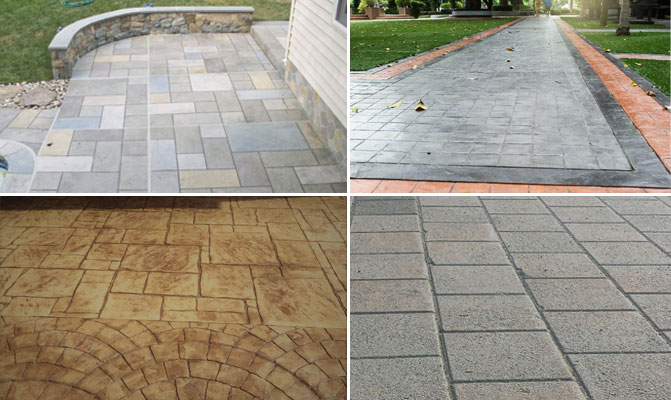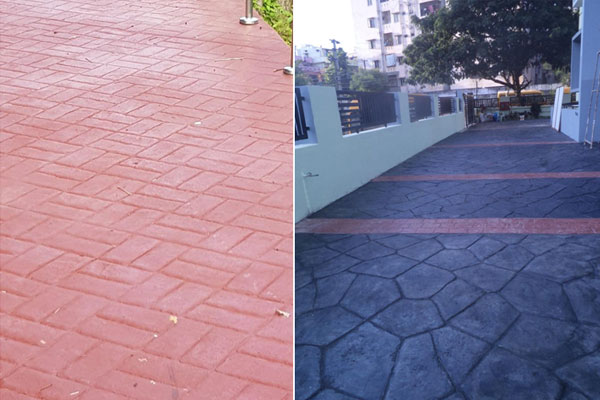Stamped concrete flooring also known as patterned concrete or imprinted concrete, uses rubber stamps designed from “real stone” molds to imprint the concrete to resemble natural brick, slate, cobblestone, tile, and even wood planks. It can be applied as an overlay that goes over your existing concrete slab or can be imprinted into freshly-poured concrete before it hardens. Stamping is a decorative treatment for new concrete surfaces. Stamped concrete has mid-range compressive strength, usually between 3000 to 4000 psi, and lasts decades if well maintained
Advantages of Stamped concrete flooring
- Better design possibilities as with many colors and pattern options
- Durable
- Faster installation
- Customisation possible
- Low maintenance requirements
- Less labor-intensive to install
- It is sealed, protecting it from weather elements
Methods for laying stamped concrete flooring
There are three procedures used in stamped concrete that separate it from other concrete procedures; the addition of a base color, the addition of an accent color, and stamping a pattern into the concrete. These three procedures provide stamped concrete with a color and shape similar to the natural building material.
Addition of base color
The base color is the primary color used in stamped concrete. The base color is chosen to reflect the color of the natural building material. The color hardener can be applied using one of two procedures; integral color or cast-on color.
Integral color is the procedure where the entire volume of concrete is dyed the base color. The entire volume of concrete is colored by adding the color hardener to the concrete truck and allowing all the concrete in the truck to be dyed. Cast-on color is the procedure where the surface of the concrete is dyed the base color. The surface of the concrete is colored by spreading the color hardener onto the surface of the wet concrete and floating the powder into the top layer of the wet concrete.
Addition of accent color
The accent color is the secondary color used in stamped concrete. The secondary color is used to produce texture and show additional building materials in the stamped concrete. The color release can be applied in one of two procedures, Cast-on color and . Spray-on color release.
Cast-on color release is a procedure where the powder color release is applied by spreading the color release on the surface of the concrete before the concrete is stamped. Spray-on color release is a procedure where the liquid color release is sprayed on the bottom of the concrete stamps before the concrete is stamped.
Stamping patterns
The pattern is the shape of the surface of the stamped concrete. The pattern reflects the shape of the natural building material. The pattern is made by imprinting the concrete shortly after it has been poured with a “concrete stamp”. Concrete stamps are placed on the concrete after the color release has been applied. The concrete stamps are pushed into the concrete and then removed to leave the pattern in the stamped concrete.
The steps for laying stamped concrete flooring

There are many steps involved in stamped concrete that must be executed carefully and quickly to achieve uniform results across the entire slab before the concrete sets. The steps are as followed;
- Casting the concrete by pouring the mix design into the desired area
- One needs to wait for the bleed water to evaporate from the surface of the concrete.
- Concrete should be compacted and leveled to the desired thickness
- Colour Hardener must be spread over the surface by hand
- A concrete float should be done now by hand on the freshly prepared concrete to create a smooth surface
- Dry-shake the color release ready to receive stamping tools that will form the pattern in the surface
- Piece the stamping tools together, ensure that they are aligned to provide a consistent pattern
- Apply weight to the stamping tools evenly and use a textured wheel over any areas that need more definition
- Allow this freshly stamped concrete to cure for 24 hours
- Saw in the expansion joints to avoid cracking
- After the curing period, dust and dirt can be washed off the surface.
- Remove residual materials and dirt
- The final step is sealing the concrete
The application procedure can also only give satisfactory results when few things are well maintained such as sub-grade preparation, maintaining joint cut specifications, the concrete mix and proper reinforcement in the concrete layer. Always take expert supervision for application as the placing of concrete in the concrete stamping procedure is complicated.
Application areas of Stamped concrete flooring

- Exterior patio
- Pool deck
- Driveway
- Walkways
- Seat walls
- Pathways
- Commercial;- interior and exterior
Conclusion
Stamped concrete can be designed in various ways. Whatever complex design you may need for your plan, stamped concretes can be used alongside other decorative material.
Image Source: Neocrete.co.in, southfloridareporter.com, becosan.com, jvlandscapes.com metrocrete.com



